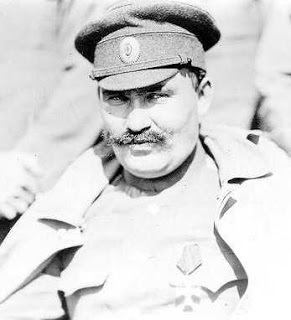Allegiance Russian Empire Years of service 1911-21 | Name Grigory Semyonov Rank Lieutenant general | |
 | ||
Born September 25, 1890
Kuranzha Village, Transbaikal Oblast, Russian Empire ( 1890-09-25 ) Battles/wars World War I
Russian Civil War Awards Order of St. George (twice) Died August 30, 1946, Moscow, Russia Battles and wars World War I, Russian Civil War Service/branch Imperial Russian Army, White movement Similar People Alexander Kolchak, Vladimir Kappel, Alexander Dutov, Mikhail Diterikhs, Anton Denikin | ||
Grigory Mikhaylovich Semyonov, or Semenov (Russian: Григо́рий Миха́йлович Семёнов; September 13 (25), 1890 – August 30, 1946), was a Japanese-supported leader of the White movement in Transbaikal and beyond from December 1917 to November 1920, Lieutenant General and Ataman of Baikal Cossacks (1919).
Contents

Biography

Semyonov was born in the Transbaikal region of eastern Siberia. His father, Mikhail Petrovich Semyonov, was of partial Buryat descent. Semyonov was a fluent Mongolian and Buryat language speaker. He joined the Imperial Russian Army in 1908, and graduated from Orenburg Military School in 1911. He was commissioned as a yesaul (Cossack ensign) and distinguished himself in battle against the Germans and Austro-Hungarians in World War I, earning the Saint George's Cross for courage.
According to Pyotr Wrangel:
Semenov was a Transbaikalian Cossack – dark and thickset, and of the rather alert Mongolian type. His intelligence was of a specifically Cossack calibre, and he was an exemplary soldier, especially courageous when under the eye of his superior. He knew how to make himself popular with Cossacks and officers alike, but he had his weaknesses in a love of intrigue and indifference to the means by which he achieved his ends. Though capable and ingenious, he had received no education, and his outlook was narrow. I have never been able to understand how he came to play a leading role.
He was somewhat of an outsider among the his fellow officers because of his ethnicity. While serving in the Caucasus in World War I he met another officer shunned by his peers, Baron Ungern-Sternberg, whose eccentric nature and disregard of the rules of etiquette and decorum repelled others. He and Sternberg tried to organize a regiment of Assyrian Christians to aid in the fight against the Turks. In July 1917 Semyonov left the Caucasus and was appointed Commissar of the Provisional Government in the Baikal region, responsible for recruiting a regiment of Buryat volunteers.
The Russian Civil War in Transbaikal
After the October Revolution Semyonov stirred up an anti-Soviet rebellion, but was defeated and fled to the northeastern Chinese city of Harbin. In August 1918 he managed to consolidate his positions in the Transbaikal region with the help of the Czechoslovak Legions and imposed his ruthless regime. In his rule over this region, he has been described as a "plain bandit [who] drew his income from holding up trains and forcing payments, no matter what the nature of the load nor for whose benefit it was being shipped." As a part Buryat Mongol, Ataman Semyonov declared a "Great Mongol State" in 1918 and had designs to unify the Oirat Mongol lands, portions of Xinjiang, Transbaikal, Inner Mongolia, Outer Mongolia, Tannu Uriankhai, Kobdo, Hulunbei'er and Tibet into one Mongolian state. The White Siberian Provisional Government appointed Semyonov commander of a detached unit with headquarters in Chita. Initially Adm. Aleksandr Kolchak refused to recognize Semyonov's authority, but he had no choice and had to accept Semyonov as de facto leader and confirm him as Commander-in-Chief of the Chita military district. In early 1919 Semyonov declared himself Ataman of the Transbaikal Cossack Host with support from the Imperial Japanese Army, elements of which had been deployed to Siberia. The region under his control extended from Verkhne-Udinsk near Lake Baikal to the Shilka River and the town of Stretensk, to Manzhouli, where the Chinese Eastern Railway met the Chita Railway, and northeast some distance along the Amur Railway.
Semyonov handed out copies of the Protocols of the Elders of Zion to the Japanese troops he became associated with. In February 1919 it was said that he allowed a Jewish unit to form in his Cossack-dominated army. His most illustrious mistress and partner was a Jewish cabaret singer named Mashka Sharaban.
After the fall of Kolchak's Siberian government, the admiral transferred power to Semyonov in the Far East. However, Semyonov was unable to keep his forces in Siberia under control: they stole, burned, murdered and raped, and developed a reputation for being little better than thugs. In July 1920 the Japanese Expeditionary Corps started a limited withdrawal in accordance with the Gongota Agreement signed with the Far Eastern Republic, undermining support for Semyonov. Transbaikal partisans, internationalists and the 5th Soviet Army under Genrich Eiche launched an operation to retake Chita. In October 1920 units of the Red Army and guerrillas forced Semyonov's tiny army out of the Baikal region. After having retreated to Primorye, Semyonov tried to continue fighting the Soviets, but was finally forced to abandon all Russian territory by September 1921.
In exile
After failing to settle in Nagasaki via Harbin, Semyonov stayed in the United States for a period of time, where he was soon accused of committing acts of violence against the American soldiers of the Expeditionary Corps. He was eventually acquitted and returned to China, where he was given a monthly 1000-yen pension by the Japanese government. In Tianjin he had ties with the Japanese intelligence community and mobilized exiled Russian and Cossack communities, planning to eventually overthrow the Russians. He was also employed by Puyi, the dethroned Emperor of China, whom he wished to restore to power.
Semyonov was captured in Dalian by Soviet paratroopers in September 1945 during the Soviet invasion of Manchuria, when the Soviet Army conquered Manchukuo. He was charged with counterrevolutionary activities and sentenced to death by hanging by the Military Collegium of the Supreme Court of the USSR. He was executed on August 29, 1946.
